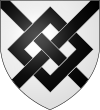Lionel Tollemache, 3rd Earl of Dysart (30 January 1649 – 23 February 1727), styled Lord Huntingtower from 1651 to 1698, was a British Tory politician and peer. A Member of Parliament at Westminster, he inherited Scottish peerages and was briefly Lord Lieutenant of Suffolk from 1703 to 1705.[1]
The Earl of Dysart | |
|---|---|
 An Unknown Gentleman, called Lionel Tollemache, 3rd Earl of Dysart (1649-1727), c. 1660, by Peter Lely | |
| Coat of arms |  |
| Predecessor | Elizabeth, 2nd Countess of Dysart |
| Successor | Lionel Tollemache, 4th Earl of Dysart |
| Born | Lionel Tollemache 30 January 1649 Helmingham Hall |
| Died | 23 February 1727 (aged 78) |
| Buried | St. Mary's Church, Helmingham, Suffolk 52°10′25″N 1°12′09″E / 52.1735°N 1.2024°E |
| Noble family | Tollemache |
| Spouse(s) |
Grace Wilbraham (m. 1680) |
| Parents | |
| Occupation | Politician |
Biography
editDysart was born on 30 January 1649 at Helmingham Hall in Suffolk, the eldest son of Sir Lionel Tollemache, 3rd Baronet (died 1669), and Elizabeth, 2nd Countess of Dysart (died 1698).[2] Educated at Queens' College, Cambridge, Lionel succeeded to his father's baronetcy on his death,[3] and to some property in Suffolk, but also a raft of debts which bred in him a habit of frugality which was not shed in later years.[4]
Political career
editIn 1673, Huntingtower contested Suffolk as a Tory; defeated by Sir Samuel Barnardiston, 1st Baronet, he had the return falsified by the sheriff, Sir William Soame, and took his seat in Parliament. An election committee declared Barnardiston elected, who initially obtained £1,000 damages from him in a suit before the King's Bench, but the decision was overturned by the Court of Exchequer Chamber. Tollemache was made a freeman of Eye in 1675. He briefly served as Member of Parliament for Orford in 1679 as a member of the Habeas Corpus Parliament. In 1685, he was again returned for that borough and was made portman of Orford, an office he held until about 1709.[4]
Huntingtower went out of Parliament again upon the fall of James II in 1688. However, he was returned for Suffolk in 1698 and generally supported Tory principles. In that year, he succeeded his mother to become Earl of Dysart, making him a member of the Parliament of Scotland, but did not take his seat there. In 1702, he was appointed Vice-Admiral of Suffolk and became (until 1716) a freeman of Dunwich, and in 1703 was appointed Lord Lieutenant of Suffolk. He was also named High Steward of Ipswich that year, an office he held until his death. As Lord Lieutenant, he purged moderate Churchmen from lieutenancy offices. He was Mayor of Orford during the summer of 1704. His support for the "Tack" of the Occasional Conformity Bill led to his removal from his county offices in April 1705. Campaigning on the basis of his support for the Tack, he was returned for Suffolk again in 1705. As a Scottish peer, he was forced to leave the House of Commons by the Acts of Union 1707.[4] He was offered a barony in the Peerage of Great Britain by Queen Anne upon her accession, but declined.[5]
Predeceased by his only son in 1712, Dysart remained a Tory and was considered a possible Jacobite, until his death. He died on 23 February 1727 and was buried at St Mary's, Helmingham.[2] His male-line grandson Lionel inherited his titles.
Marriage and issue
editOn 30 September 1680, he married Grace Wilbraham, the daughter and coheir of Sir Thomas Wilbraham, 3rd Baronet.[5] They had five children:
- Lionel Tollemache, Lord Huntingtower (1682– 26 July 1712), married, on 6 December 1706, Henrietta (d. 1718), illegitimate daughter of William Cavendish, 2nd Duke of Devonshire, and had issue:
- Lionel Tollemache, 4th Earl of Dysart
- Henrietta Tollemache
- Lady Elizabeth Tollemache (d. 6 August 1746), married Sir Robert Salusbury Cotton, 3rd Baronet
- Lady Catherine Tollemache (d. 17 January 1754), married John Brydges, Marquess of Carnarvon (15 Jan 1703 – 8 Apr 1727) on 1 September 1724
- Lady Mary Tollemache (d. 2 December 1715)
- Lady Grace Tollemache (d. 27 May 1719)
References
edit- ^ Hayton, D. W. (2002). "Tollemache, Lionel, 3rd Earl of Dysart [S] (1649-1727), of Helmingham, Suff.". In Hayton, D.; Cruickshanks, E.; Handley, S (eds.). The History of Parliament: the House of Commons 1690-1715, – via The History of Parliament Online.
- ^ a b Cokayne, George Edward (1916). Gibbs, Vicary; Doubleday, H. Arthur (eds.). The Complete Peerage of England, Scotland, Ireland, Great Britain and the United Kingdom, Extant, Extinct, or Dormant. Vol. 4 (Revised ed.). London: St. Catherine Press. pp. 563–564. LCCN 10020917. OCLC 760846.
- ^ "Tollemache, Lionel (Lord Huntingtower) (TLMC665L)". A Cambridge Alumni Database. University of Cambridge.
- ^ a b c Wedgwood, Josiah Clement (2002). The House of Commons 1690-1715. Cambridge University Press. pp. 648–649. ISBN 0-521-77221-4. Retrieved 12 January 2008.
- ^ a b Forster, Matthew (1866). Biographical Dictionary of Eminent Men of Fife. J. C. Orr. p. 159. Retrieved 12 January 2008.
External links
edit- Dysart, Earl of (S, 1643) Cracroft's Peerage
- Lionel Tollemache, 3rd Earl of Dysart with his wife, Grace Wilbraham Monument at St Mary's, Helmingham